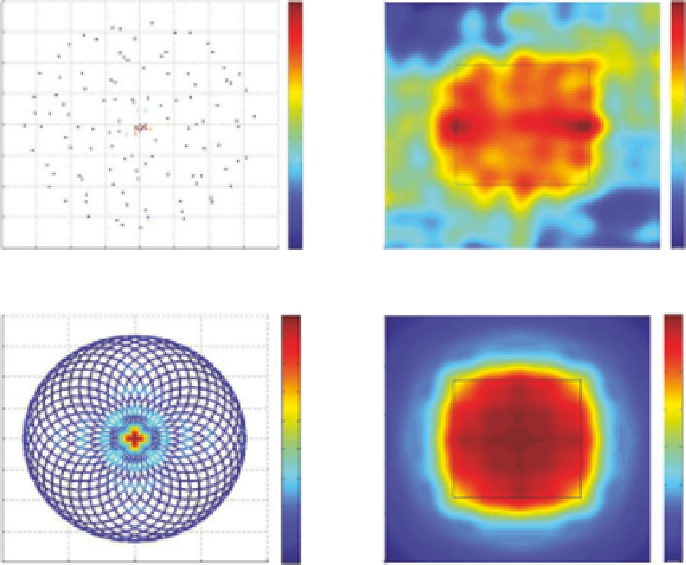Image Processing Reference
In-Depth Information
(a)
×10
-4
(b)
×10
-3
0
40
5
30
4
3.5
3
2.5
2
1.5
1
0.5
4.5
50
20
4
10
100
3.5
0
3
150
-10
2.5
-20
2
200
-30
1.5
-40
250
-40
-30
-20
-10
0
10
20
30
40
0
50
100
150
200
250
(d)
(c)
×10
-5
40
0
4
0.04
30
3.5
50
0.035
20
3
10
0.03
100
2.5
0
-10
2
0.025
150
1.5
1
0.5
0.02
-20
200
0.015
-30
-40
0.01
250
-40
-20
0
20
40
0
50
100
150
200
250
Figure 11.5
(a) Ewald circle using 12 sources and 10 receivers randomly spaced. (b) Resulting reconstructed
image from (a). (c) Ewald circle using 36 source and 360 receivers equally spaced for comparison with (a) and (b).
(d) Resulting image from (c).
sources and 360 receivers. It is entirely possible that the minimum has been
met in this case. There simply is not enough evidence at this point to say con-
clusively if this describes the overall degrees of freedom relationship.
Having now observed the evidence that there does seem to be an overall
degrees of freedom criterion, it seems appropriate not to test this idea a bit
more thoroughly to see if this concept holds true and if so, whether there
appears to be a consistent threshold that we can identify and possibly even
quantify as an overall degrees of freedom criterion. To do this, we will exam-
ine two different targets over a range of permittivites for the scenarios of the
number of randomly but equally spaced data points that correspond to
N
2
/2,
N
2
, 2
N
2
and 4
N
2
. These images are then compared to the maximum degrees
of freedom case for this experiment which is
N
= 12,960 for comparison. The
results from testing circular targets are shown in Table 11.2. It is clear from
these images that, for the cases of
N
2
/2 and
N
2
total data points, the degrees of
freedom are clearly not satisfied for any of the permittivity cases. The images
are starting to take shape for the 2
N
2
case for all permittivity values, but still
appear as if they have not quite satisfied the overall number of degrees of free-
dom. Once the number of data points reaches the 4
N
2
case, it is evident that
the image is fairly well formed for all permittivity ranges. This strongly sug-
gests that the overall degrees of freedom criterion have been satisfied at this
point for all permittivities for this class of target.

Search WWH ::

Custom Search